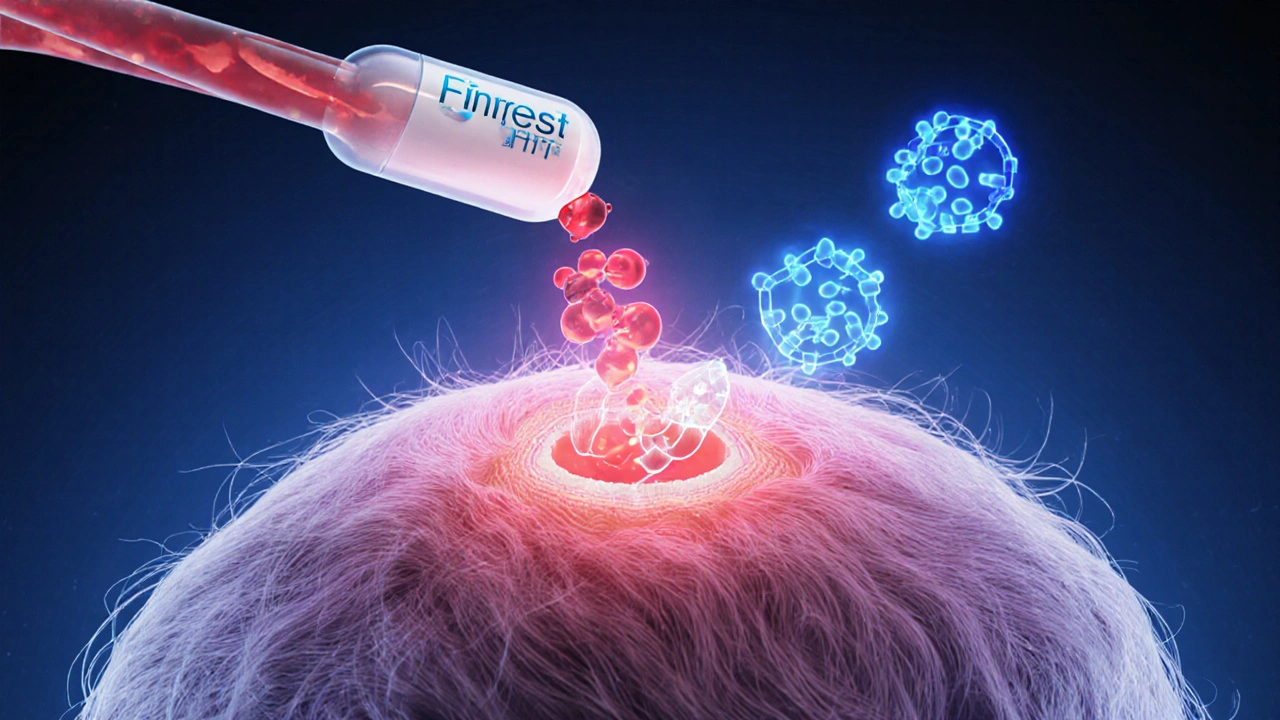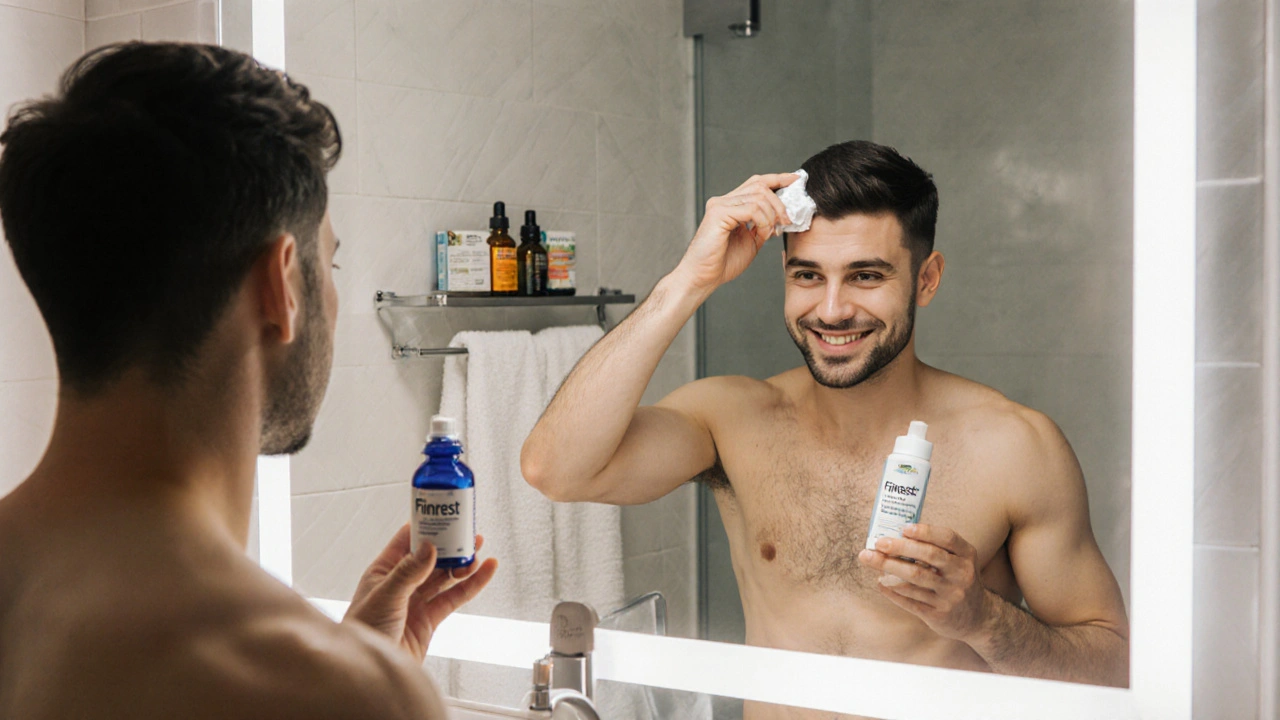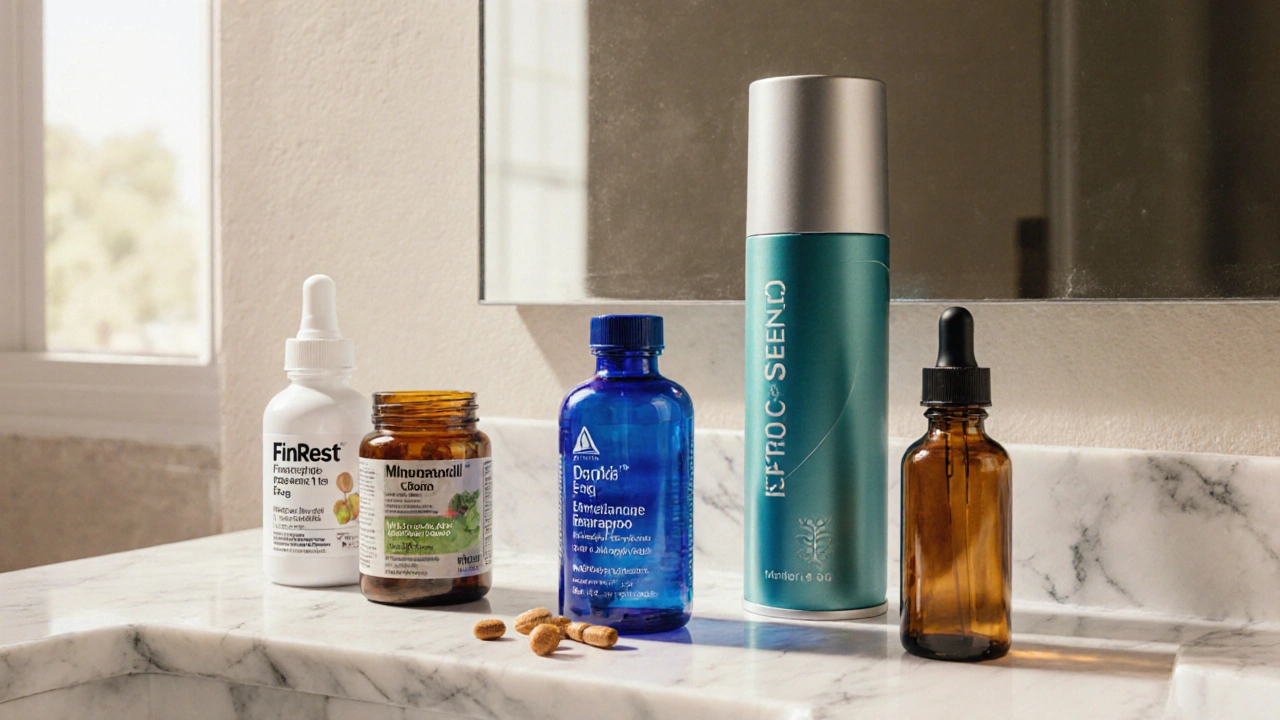Finrest vs. Alternatives Comparison Tool
Select a treatment and your primary concern, then click Compare to see detailed insights.
Finrest (Finasteride)
Most clinically proven oral treatment for male-pattern hair loss. Blocks DHT production by 70% with 1mg daily dose.
Sexual Side Effects $30/month High EffectivenessDutasteride
Stronger DHT suppression (up to 90%) but higher risk of sexual side effects. Off-label use at 0.5mg daily.
Higher Side Effects $45/month Very High EffectivenessSaw Palmetto
Plant-derived extract with mild 5-alpha-reductase inhibition. Good for early-stage thinning with minimal side effects.
Minimal Side Effects $20/month Moderate EffectivenessMinoxidil (Topical)
Vasodilator that prolongs growth phase. Can be combined with any oral treatment. Applied twice daily.
Scalp Irritation $25/month Moderate EffectivenessKey Takeaways
- Finrest (finasteride) blocks DHT production and is the most clinically proven oral treatment for male‑pattern hair loss.
- Dutasteride offers stronger DHT suppression but carries a higher risk of sexual side effects.
- Natural options such as saw‑palmetto and pumpkin seed oil provide modest results and are best for early‑stage thinning.
- Topical minoxidil works by stimulating follicles, not by altering hormones, so it can be combined with any oral option.
- Cost, prescription requirements, and personal tolerance to side effects often decide which product fits you best.
What Is Finrest?
Finrest is the brand name for finasteride, a 5‑alpha‑reductase inhibitor that reduces dihydrotestosterone (DHT) levels in the scalp. It was first approved by the FDA in 1997 for benign prostatic hyperplasia and later received a 1mg dosage approval for androgenetic alopecia in men. By blocking the enzyme that converts testosterone to DHT, Finrest helps shrink miniaturized hair follicles, slowing hair loss and often regrowing thin strands over 6‑12months.
How Finrest Works
The drug targets the typeII isoform of the 5‑alpha‑reductase enzyme. DHT is the main hormone that shortens the anagen (growth) phase of hair follicles on the vertex and front scalp. When DHT levels drop about 70% after a daily 1mg dose, follicles receive a healthier hormonal environment, allowing thicker hairs to emerge. The effect is systemic, so the medication is taken orally, usually with a glass of water.

Common Alternatives Overview
While Finrest remains the gold standard for oral therapy, several alternatives exist. Below, each option is introduced with its own micro‑data definition to aid search engines.
Dutasteride is a dual 5‑alpha‑reductase inhibitor that blocks both typeI and typeII enzymes, delivering up to 90% DHT reduction. It’s FDA‑approved for enlarged prostate but used off‑label for hair loss at 0.5mg daily. The stronger suppression can translate to faster thinning reversal, yet the broader enzyme block often raises the incidence of libido and erectile concerns.
Saw palmetto is a fruit‑derived extract that weakly inhibits 5‑alpha‑reductase, especially the typeII variant. Typical doses range from 160mg to 320mg per day in capsule form. Clinical trials show 10‑15% improvement in hair density, making it a gentle, over‑the‑counter option for early‑stage thinning.
Minoxidil is a topical vasodilator originally developed for hypertension. In a 5% solution for men, it prolongs the anagen phase and increases follicle size. Because it works without hormone modulation, it can be layered under any oral drug, but results usually appear after 4‑6months of twice‑daily application.
Spironolactone is a potassium‑sparing diuretic that also antagonizes androgen receptors. Though rarely prescribed to men because of feminizing side effects, it’s common in women with hormonal hair loss, often at 50‑100mg daily.
Ketoconazole is an antifungal shampoo that reduces scalp inflammation and may modestly inhibit 5‑alpha‑reductase. A 2% formulation used twice a week can add 5‑10% extra hair count when paired with oral treatment.
Pumpkin seed oil is a cold‑pressed oil rich in phytosterols, which are thought to block DHT binding at the follicle level. Studies on 400mg daily capsules report a 10‑12% increase in hair count after 24weeks, positioning it as a low‑risk natural adjunct.
Side‑By‑Side Comparison
| Attribute | Finrest (Finasteride) | Dutasteride | Saw Palmetto | Minoxidil (Topical) | Spironolactone | Ketoconazole Shampoo | Pumpkin Seed Oil |
|---|---|---|---|---|---|---|---|
| Mechanism | TypeII 5‑α‑reductase inhibitor | Dual typeI &II inhibitor | Weak typeII inhibitor (plant extract) | Vasodilator; prolongs anagen phase | Androgen‑receptor antagonist | Antifungal; mild 5‑α‑reductase inhibition | Phytosterol DHT blocker |
| FDA status (hair loss) | Approved (1mg) | Off‑label | Supplement (OTC) | Approved (5%) | Off‑label (women) | OTC (2% shampoo) | Supplement (OTC) |
| Typical dose | 1mg daily | 0.5mg daily | 160-320mg daily | 1mL twice daily | 50-100mg daily | Twice weekly wash | 400mg daily |
| Hair‑count improvement (clinical avg.) | ≈25% over 12mo | ≈30% over 12mo | ≈12% over 6mo | ≈15% over 6mo | ≈20% (women only) | ≈8% when combined | ≈10% over 24wk |
| Common side effects | Reduced libido, erectile dysfunction, ejaculatory delay | Higher incidence of sexual side effects; occasional breast tenderness | Mild GI upset, rare headache | Scalp irritation, itching | Menstrual irregularities, breast tenderness | Dryness, occasional itching | None reported in trials |
| Average monthly cost (US$) | ≈30 (generic) | ≈45 (generic) | ≈20 | ≈25 (brand) | ≈15 | ≈12 (OTC shampoo) | ≈18 |
Choosing the Right Option for You
Think of the decision as a checklist of three pillars: effectiveness, tolerance, and practicality.
- Effectiveness: If you need the strongest proven DHT reduction, dutasteride edges out finasteride, but the jump is modest (≈5%). For mild thinning, a plant‑based extract may be enough.
- Tolerance: Sexual side effects are the main deal‑breaker for oral inhibitors. Women who can’t take finasteride often turn to spironolactone or topical solutions.
- Practicality: Prescription requirements, insurance coverage, and how comfortable you are with daily pills versus twice‑daily foam matter. Minoxidil’s easy topical route appeals to those wary of systemic meds.
In practice, many clinicians start patients on Finrest, add minoxidil after three months, and keep a low‑dose ketoconazole shampoo on hand for scalp health. If a patient reports persistent sexual dysfunction, they may switch to dutasteride at a reduced dose or step down to saw‑palmetto.
Side‑Effect Deep Dive
Finrest’s most discussed risk is post‑finasteride syndrome (PFS), a controversial set of persistent sexual and mood changes after stopping the drug. While incidence is low (<2% in large cohort studies), it’s enough to merit a trialperiod of 3‑6months before committing long‑term.
Dutasteride shares the same hormonal pathway but hits both enzyme isoforms, which can increase the prevalence of erectile issues to roughly 4% in meta‑analyses. The extra efficacy is often not worth the extra risk for men under 30.
Natural alternatives like saw‑palmetto and pumpkin seed oil report negligible systemic side effects, but their modest efficacy means they are best paired with a proven treatment rather than used solo.
Topical minoxidil can cause scalp irritation and, rarely, unwanted facial hair (especially in women). Using a gentle moisturizer or switching to a foam formulation reduces irritation in 80% of users.

Cost and Accessibility
Finrest’s generic version costs about $30 a month in the US, and many UK pharmacies carry it for £8‑£12 per 30‑tablet pack under the NHS prescription scheme, making it affordable for long‑term use.
Dutasteride’s generic price is higher, partly because fewer manufacturers produce it. In the UK, it’s generally a private prescription, ranging from £35‑£45 per month.
OTC options-saw‑palmetto capsules, pumpkin seed oil, and ketoconazole shampoo-are widely available in supermarkets and health stores. Their monthly outlay rarely exceeds $20, but remember they’re adjuncts, not stand‑alone cures.
Practical Tips for Getting the Most Out of Your Treatment
- Take Finrest with food to reduce occasional stomach upset.
- Blood tests aren’t required for finasteride, but a baseline PSA (prostate‑specific antigen) can be helpful for men over 40.
- If you notice erectile changes, discuss a dose reduction or a “drug holiday” of two weeks-many users regain normal function without losing hair benefits.
- Combine oral therapy with 5% minoxidil for synergistic gains; the duo can deliver up to 40% hair‑count improvement in a year.
- Use a gentle sulfate‑free shampoo to keep scalp oils balanced; harsh cleansers can blunt minoxidil absorption.
Next Steps & Troubleshooting
Start with a 3‑month trial of Finrest at the standard 1mg dose. Track progress with weekly photos and note any side effects. If after 12weeks you see no change or experience bothersome sexual symptoms, consider switching to dutasteride at 0.5mg or adding a natural supplement like saw‑palmetto.
For women or men who cannot tolerate any oral anti‑androgen, shift focus to topical therapies (minoxidil, ketoconazole) and hormonal blockers like spironolactone (women only). Consistency is key-most treatments need at least six months of daily use before measurable growth appears.
Frequently Asked Questions
Can I use Finrest and dutasteride together?
No. Both drugs suppress the same hormone pathway, so combining them offers no extra benefit and raises the risk of side effects. Choose one or the other based on how strong DHT reduction you need.
Is saw‑palmetto a safe substitute for finasteride?
It’s safe for most people, but its DHT‑blocking power is much weaker. Expect only modest improvement, making it better as an adjunct or for those who cannot handle prescription meds.
How long does it take to see results with Finrest?
Most users notice a slowdown of hair loss within 3months and visible regrowth after 6‑12months. Patience and consistent daily dosing are essential.
Are there any long‑term health concerns with finasteride?
Large cohort studies show no increase in prostate cancer risk when used at the 1mg dose. The main concern is persistent sexual or mood changes in a minority of users, which should be discussed with a physician.
Can I switch from finasteride to minoxidil after a year?
Yes. Some people stop oral therapy once they’ve achieved a stable hair count and maintain results with minoxidil alone. Keep an eye on any renewed shedding during the transition period.


Anastasia Petryankina
October 10, 2025 AT 16:13Oh, because we all needed another glossy chart to decide whether to lose hair or lose our wallets.
Tim Ferguson
October 12, 2025 AT 23:46Well, if you think a table can replace a dermatologist’s counsel, you’re missing the point. The data’s nice, but real‑world adherence matters. Plus, the side‑effect list isn’t just a footnote.
Noah Cokelaere
October 15, 2025 AT 07:20Look, the guide nails the basics, but you can’t ignore that finasteride’s sexual side effects are a real deal for many. Saw palmetto might be a gentler entry, though its efficacy is modest. And don’t forget minoxidil’s scalp irritation if you’re prone to eczema.
Ashley Helton
October 17, 2025 AT 14:53Sure, the comparison is thorough, but the “most affordable” tag ignores insurance discounts that can make finasteride cheaper than the “budget” options.
Brian Jones
October 19, 2025 AT 22:26Honestly, the breakdown is clear, concise, and-let’s be honest-quite useful; however, one should also consider the long‑term hormonal impact, which the table subtly downplays; therefore, a physician’s input remains indispensable.
Carlise Pretorius
October 22, 2025 AT 06:00i think the chart is ok but it doesnt show real life cost when ur on a budget its definetly missing the out of pocket stuff
Johnson Elijah
October 24, 2025 AT 13:33Great stuff! 👍💡 If you’re looking for a low‑risk start, saw palmetto is a decent door‑opener. 🌱
Roxanne Lemire
October 26, 2025 AT 21:06the guide is helpful but i cant help but notice the phrasing is a bit off its like theres too many technical jargons for a newbie
Alex Mitchell
October 29, 2025 AT 04:40Interesting read :) just wanted to add that rotating between minoxidil and ketoconazole can sometimes keep the scalp from getting too dry.
Narayan Iyer
October 31, 2025 AT 12:13From a pharmacoeconomic perspective, the cost‑effectiveness ratio of dutasteride versus finasteride pivots on the marginal utility derived from that extra ~5% DHT suppression, which may not justify the incremental adverse event probability in a low‑risk cohort.
Amanda Jennings
November 2, 2025 AT 19:46Yo, love the interactive tool! I’m definitely trying finasteride for a month then adding minoxidil-let’s see if the combo lives up to the hype!
alex cristobal roque
November 5, 2025 AT 03:20Finasteride has been the cornerstone of male‑pattern alopecia treatment for decades, and its mechanism of selectively inhibiting type II 5‑alpha‑reductase is well documented in peer‑reviewed literature.
The typical 1 mg daily regimen reduces scalp DHT by roughly 70%, which translates into a measurable increase in hair‑shaft diameter for many users.
Clinical trials consistently show about a 25 % improvement in hair count after twelve months, although individual response can vary widely.
One of the most frequently discussed drawbacks is the sexual side‑effect profile, which includes decreased libido, erectile dysfunction, and ejaculatory delay in a minority of patients.
These side effects are dose‑dependent, and some clinicians opt for a lower off‑label dose of 0.5 mg to balance efficacy and tolerability.
Patients should also be aware of the controversial post‑finasteride syndrome, a set of persistent symptoms that some report after discontinuation, though its prevalence remains low.
From a cost standpoint, generic finasteride sits around $30 per month in the United States, making it one of the more affordable prescription options.
Insurance coverage can further reduce out‑of‑pocket expenses, especially when a dermatologist writes the prescription.
If a patient experiences intolerable side effects, switching to dutasteride is a common strategy, as it offers slightly higher DHT suppression-up to 90 %-but also carries a higher risk of sexual dysfunction.
For those preferring a non‑prescription route, saw palmetto provides a mild DHT‑blocking effect with minimal side effects, though the hair‑count improvement hovers around 10–15 %.
Topical minoxidil remains a valuable adjunct because it works via a completely different pathway, enhancing follicular blood flow and prolonging the anagen phase.
Studies suggest that combining minoxidil with an oral 5‑alpha‑reductase inhibitor can yield additive benefits, often pushing overall improvement toward the upper 30 % range.
Ketoconazole shampoo, while primarily an antifungal, can add an extra 5–10 % boost when used twice weekly alongside oral therapy, thanks to its mild anti‑androgenic properties.
Patients should also consider lifestyle factors such as nutrition, stress management, and smoking cessation, as these can modulate treatment outcomes.
Regular follow‑up appointments every three to six months allow clinicians to monitor progress and adjust dosages or add adjunctive therapies as needed.
In summary, finasteride offers a well‑balanced blend of efficacy, affordability, and accessibility, but it requires careful patient education regarding potential sexual side effects and the importance of adherence.
Bridget Dunning
November 7, 2025 AT 10:53Dear readers, I must commend the authors for their exhaustive tabulation, yet I find the omission of longitudinal safety data somewhat disconcerting; prudence dictates a more thorough disclosure.
Shweta Dandekar
November 9, 2025 AT 18:26It is absolutely imperative, for the sake of public health, that we scrutinize any pharmaceutical that alters hormonal pathways; otherwise, we risk compromising societal moral standards!!!
Gary Smith
November 12, 2025 AT 02:00Patriotic citizens should support home‑grown solutions over foreign conglomerates; our very identity hinges on self‑reliance in health matters!!!
Dominic Dale
November 14, 2025 AT 09:33The pharmaceutical lobby has been quietly steering the narrative around hair loss for decades, funneling subtle cues into mainstream media.
Every new ‘comparison tool’ that pops up online is just another layer of obfuscation designed to keep consumers dependent on patented drugs.
Finasteride, for instance, is marketed as a safe, reversible solution, yet the same agency that approves it also funds studies that downplay adverse events.
If you look closely, you’ll notice a pattern: every time a cheaper natural alternative gains traction, funding for independent research mysteriously dries up.
The CDC’s silence on post‑finasteride syndrome is not negligence; it’s a calculated omission to protect corporate interests.
Even the FDA’s “off‑label” designation for dutasteride feels like a backhanded invitation to experiment without proper oversight.
Social media influencers, often paid by supplement manufacturers, act as the new gatekeepers, propagating anecdotal success stories while omitting the failures.
The structured data in the HTML tables, while seemingly transparent, can be manipulated to prioritize certain products in search engine results.
Micro‑targeted ads on platforms like TikTok and Instagram funnel vulnerable young men into a pipeline that ends in a lifetime of medication.
Meanwhile, the benefits of entries like pumpkin seed oil are buried under layers of SEO‑driven content that never reaches the average user.
All of this points to a coordinated effort to keep the public’s hair follicles-and wallets-under control.
The only real antidote is critical thinking and a refusal to accept the curated narrative at face value.
christopher werner
November 16, 2025 AT 17:06I appreciate the thoroughness of this guide; it offers a solid foundation for anyone considering treatment options.
Matthew Holmes
November 19, 2025 AT 00:40the chart paints a picture of hope cut short by whispers of doubt and the silent roar of consequence
Achint Patel
November 21, 2025 AT 08:13One could argue that the very act of quantifying hair loss reduces a deeply personal experience to mere data points, thereby stripping it of its existential weight.
Zane Nelson
November 23, 2025 AT 15:46While the compilation exhibits a certain degree of diligence, it ultimately fails to transcend the pedestrian realm of mere aggregation, offering little in the way of novel insight.